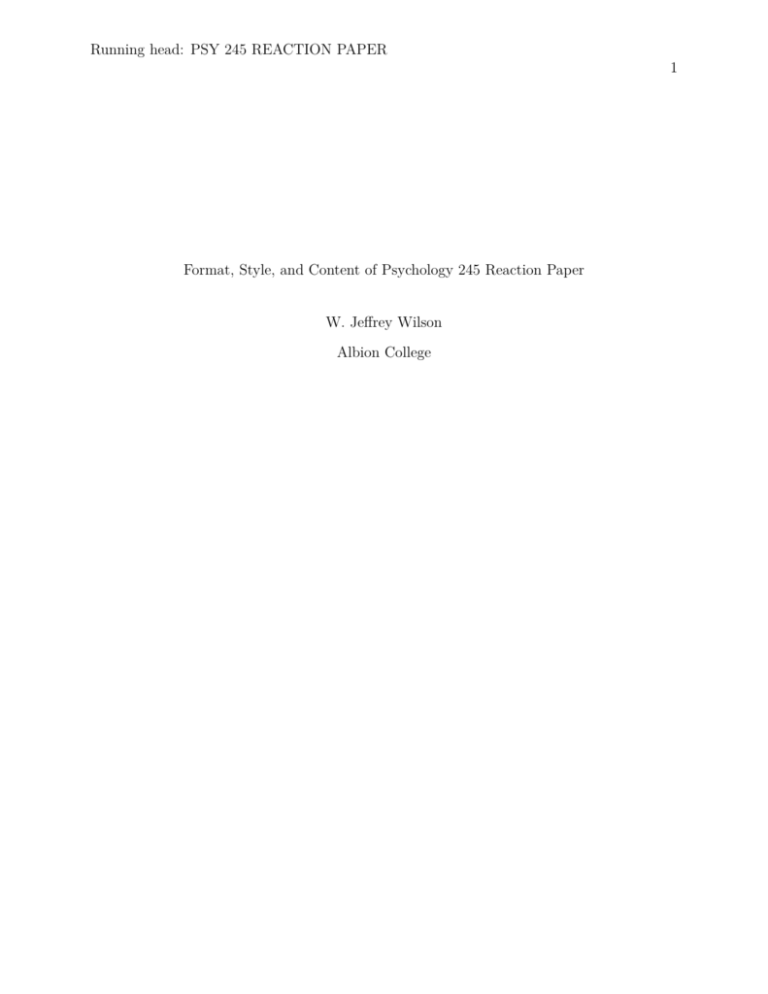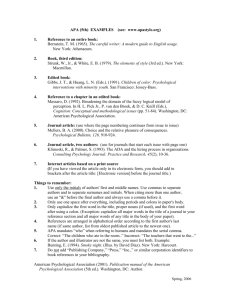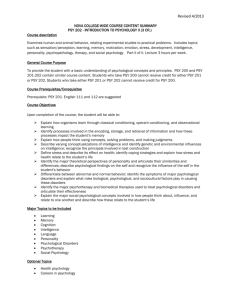Running head: PSY 245 REACTION PAPER 1 Format, Style
advertisement

Running head: PSY 245 REACTION PAPER 1 Format, Style, and Content of Psychology 245 Reaction Paper W. Jeffrey Wilson Albion College PSY 245 REACTION PAPER 2 Abstract A reaction paper addressing a published study on learning is required in PSY 245. The paper should adhere to the editorial style guidelines of the American Psychological Association. The writing style must be clear, concise, and grammatical, and the work that you turn in must be your own. Select any paper published in a learning journal within the past 10 years, and clear it with me before you begin. A timetable of important dates is included. This paper conforms to the guidelines that you should follow; use it as an example. PSY 245 REACTION PAPER 3 Format, Style, and Content of Psychology 245 Reaction Paper As stated on the course syllabus, a reaction paper is required in this course. Its purpose is to allow you to gain experience with the psychological literature and demonstrate your ability to comprehend learning research. This handout provides information regarding format, style, and other “mechanical” aspects of the paper, as well as some suggestions about your choice of papers. Format Scientific writing usually follows a strict stylistic format. This allows the reader to focus on the content of the paper rather than on how the material is presented. Your paper is no exception. The paper should adhere to the editorial style of the American Psychological Association, as outlined in the Publication Manual of the American Psychological Association, (6th edition, 2010). This book is in the library, and is available in the bookstore. The following list summarizes some of the major requirements of APA style. 1. Type all parts of the manuscript double-spaced, using Times New Roman 12-point font. Use only one side of the paper. Do not right-justify the text. 2. In the top left corner of every page provide the label “Running head:” followed by the actual running head (a shortened version of the title, not exceeding 50 characters), in all caps. The page number should appear in the upper right corner of each page. 3. Page 1 should be a numbered title page, giving the title (no more than 12 words), author’s name, and author’s affiliation (in this case, Albion College). Author Note, if necessary, appears below the author’s affiliation. 4. Page 2 should consist of an abstract providing a brief overview of your paper. It should be labeled “Abstract,” and should not exceed 250 words. The abstract should be typed as a single, non-indented paragraph. 5. The body of the paper follows, beginning on Page 3. As this is not a research report, there is no need for sections such as Method, Results, etc. The text can be one PSY 245 REACTION PAPER 4 uninterrupted section, or can be broken down into subsections, as you deem necessary. 6. Citations of source material in the body of the text should take the form of the name(s) of the author(s) followed by the date of publication; for example, Authorone (1968), Authorone and Authortwo (1984). When there are three, four, or five authors, the names of all authors are required only at the first citation (Firstauthor, Secondauthor, Thirdauthor, & Fourthauthor, 1982); subsequent citations should be shortened (Firstauthor et al., 1982). If there are more than five authors, shorten the citation always, even the first time, to the first author’s last name and “et al.” Citation information that is not part of the sentence is placed within parentheses: “In 1984, Authorone and Authortwo replicated the important early finding by Authorone (1968) that chocolate facilitates migratory behavior in yaks; others (Firstauthor et al., 1982) have demonstrated this as well.” 7. Following the body of the text, and starting on a separate page, come the References. This is not a bibliography. It should contain only those papers to which you refer in the body of the text, not everything you have read. Arrange the references alphabetically by first author’s last name, and chronologically when two or more papers have the same authors in the same order (unless the papers are identified as parts of a series, in which case use the series order). List all authors’ last names and initials if there are up to seven authors. If there are eight or more authors, include the names of the first six, an ellipsis, and the last author’s name. The format required for various types of reference materials appears in the Reference section of this paper. Be sure to include all of the papers that you cite. Accuracy in citing your references is crucial! NOTE: This deviates from APA style, but you must provide a photocopy of the first page of every paper that you cite. This provides some assurance that you had the opportunity to read the papers, rather than relying on someone else’s description of the research (see discussion of primary sources, below). There is an automatic loss of 5% of the total possible value of the paper for each instance in which a photocopy is not provided. Please append the photocopies to the end of the paper. PSY 245 REACTION PAPER 5 8. Any Tables or Figures appear after the References. Tables come immediately after the References, and should be double spaced. Figures come last; a figure caption should appear under each figure on the same page. (It is unlikely that Tables and Figures will be required, but if they are, please follow this format.) The paper should be 5 or 6 pages long, excluding title page, abstract, and references. Consult the APA Publication Manual regarding the desired style for items not discussed above, such as numbers, abbreviations, seriation, etc. Your grade will reflect in part the degree to which you comply with APA style guidelines. Writing Style Scientific writing requires clarity and accuracy. Please write grammatically; do not include sentence fragments, verbs that do not agree with their subjects, dangling participles, or split infinitives. If you need assistance with your writing, contact any grammar or composition text, or a reference book such as Hacker (1998) or Strunk and White (1979). (Do not rely on any source other than the APA Publication Manual for information about APA style.) To ensure that you have presented material clearly, it is very good practice to write the paper, then put it aside for 1 or 2 days. If upon your rereading of it the paper still makes sense to you, it is probably fairly clear. If not, do some rewriting. Please be sure to proofread the paper before turning it in. As I have said often in marginal comments on students’ papers, “If you do not care enough to read this paper, why should I?” Please take the time to proofread. I will read and comment on a typed or printed draft of the paper if you give it to me no later than the date specified below. This will in no way guarantee you any particular grade on the paper, but will allow you to find out if there are some serious oversights that need to be corrected. PSY 245 REACTION PAPER 6 Appropriate References Please realize that you are writing an academic paper, and as such must rely on academic references. This means that the papers to which you refer should appear in scientific journals such as Learning & Behavior, Learning & Memory, or Journal of Experimental Psychology: Animal Behavior Processes (there are many others). These are all refereed journals, meaning that papers are reviewed by others knowledgeable in the field before they are published. They are also primary sources, meaning that the papers you read in these journals are written by the scientists who did the research leading to the papers. All of your references should be primary sources, and most should be drawn from refereed journals (although books or book chapters that are primary works are also acceptable). Magazines such as Psychology Today, Scientific American, or Newsweek are usually not appropriate as references in a scientific paper. A textbook is also inappropriate. These works are secondary, not primary, sources; they report studies that were done by others. However, such sources are often good leads, suggesting avenues of investigation into the scientific literature. If Newsweek describes Dr. Smith’s work on the extinction of phobias, do not cite Newsweek. Instead, find Dr. Smith’s work in scientific journals. If you rely on the internet or other electronic sources of articles, you must have access to the entire article, not the abstract alone. In the case of electronically accessed articles, you must provide with your paper the page containing the title and citation information, and at least one page of text indicating that the actual text of the article, rather than simply the abstract, was available to you. The most important reason for citing the primary source is accuracy. Relying on a secondary source means accepting someone else’s interpretation of the original work. Often this is fine, but equally often you will discover that the author of the secondary source is biased or inaccurate in his or her interpretation. Thus, your understanding of the original experiment will also be inaccurate or biased. PSY 245 REACTION PAPER 7 Academic Honesty It is unfortunate that this section must be included, but experience suggests that it is necessary. The work that you turn in must be your own. It is acceptable, in fact it is essential, that your paper be based on the work of other people; their contributions must be acknowledged. It is appropriate to read a paper, take notes on it in your own words, and refer to the findings of that paper in your own words, with proper citation, when you write your paper. It is entirely inappropriate to quote directly without citation, or even to paraphrase with or without citation. Substituting synonyms into someone else’s text and then retyping it is not acceptable. Plagiarism is defined by Guralnik (1970) as the act of taking (ideas, writings, etc.) from (another) and passing them off as one’s own. Pages 349–350 of the APA Publication Manual provide a very good discussion of this issue. Some good web-based sources regarding plagiarism are available through the psychology department’s web page (http://www.albion.edu/psychology). Consult these sources or see me if you have any questions about academic honesty. If your paper contains plagiarized material you will receive a grade of 0 and the matter will be referred to the Dean of Students (as required by the Student Handbook). Issues Related to Content Your paper may address any paper published within the past 10 years relating to learning theory. Our library contains many journals that publish such studies, including the three that were mentioned above in the section on Appropriate References. Scan the contents of several issues of some of these journals, and consider an article that is both interesting to you and about which you feel you have something to say. Once you have selected a paper, give me a copy so that I can approve your choice (I will return the copy to you). Your paper should address PSY 245 REACTION PAPER 8 • the main focus of the article: what did they do and why did they do it, • the nature of the learning that was examined (Pavlovian, instrumental, something else), with your justification for this decision, • the context of the study: what other research or what theoretical concerns caused the investigators to do the study, • any interesting studies that followed up on your target article. I will be glad to offer guidance if you have questions about any of these items. Time Table 1. By Thursday, March 22: Choose a target article and give me a copy. This is worth 10% of the value of the paper. 2. By April 10: Optional: give me a printed draft of the paper for comment. 3. Monday, April 16, in class: Final version of the paper due. Late papers will be penalized at a rate of 10% per day. There will be no exceptions to this policy. Please submit a printed copy of the paper, and email a copy to me at wjwilson@albion.edu. The emailed copy must be in .doc, LATEX, or .pdf format unless you make other arrangements with me ahead of time. PSY 245 REACTION PAPER 9 References American Psychological Association. (2010). Publication manual of the American Psychological Association (6th ed.). Washington, DC: Author. Authorone, A. B. (1968). Paper by a single author in a journal. Name of the Journal: Italicized and Capitalized, 21, 142–157. Authorone, A. B., & Authortwo, C. D. (1984). Chapter by two authors in a book. In E. F. Bookeditor (Ed.), Name of the book: Italicized but not all capitalized (pp. 123-178). Albion, MI: Name of Publisher. Firstauthor, G. H., Secondauthor, I. J., Thirdauthor, K. L., & Fourthauthor, M. N. (1982). Journal article written by several authors. Name of the Journal: Italicized and Capitalized, 87, 734-746. Guralnik, D. B. (Ed.). (1970). Webster’s new world dictionary of the American language. New York: World. Hacker, D. (1998). The Bedford handbook (5th ed.). Boston: Bedford. Strunk, W., Jr., & White, E. B. (1979). The elements of style (3rd ed.). New York: Macmillan.



